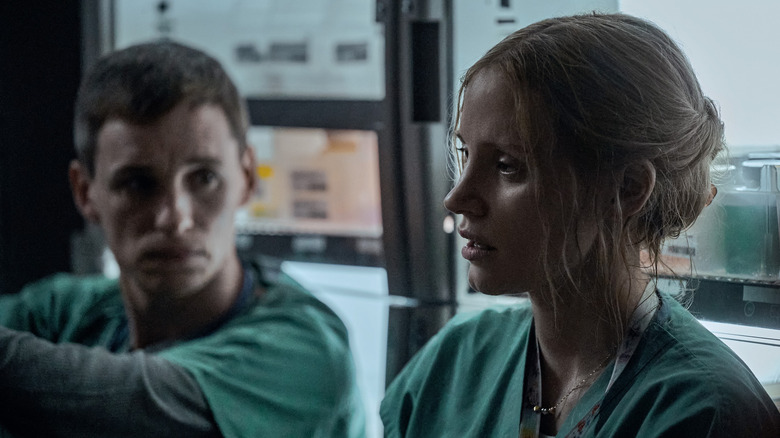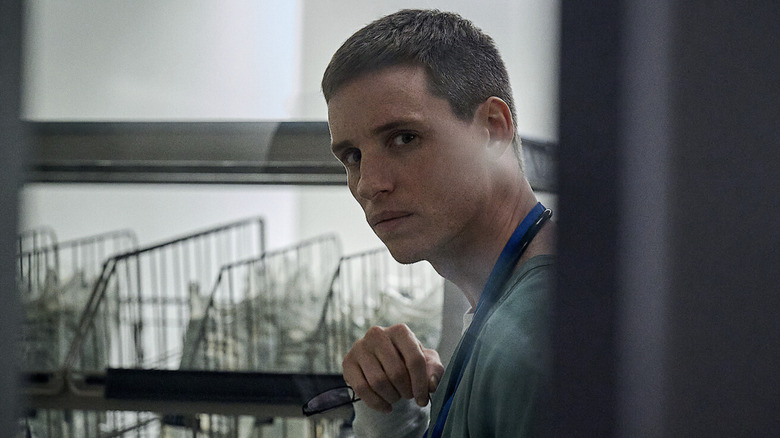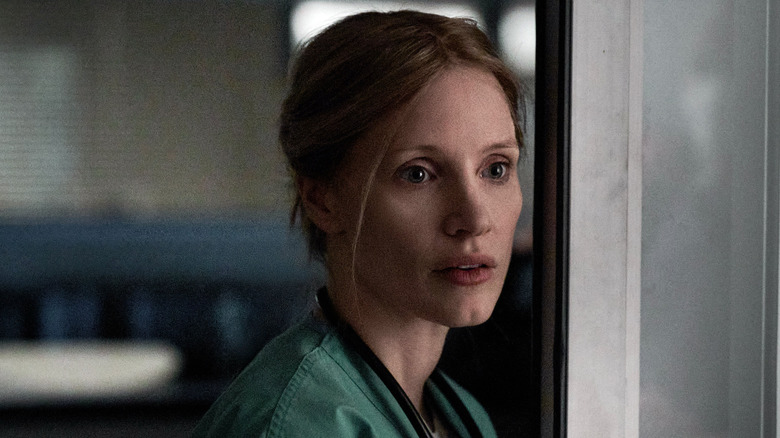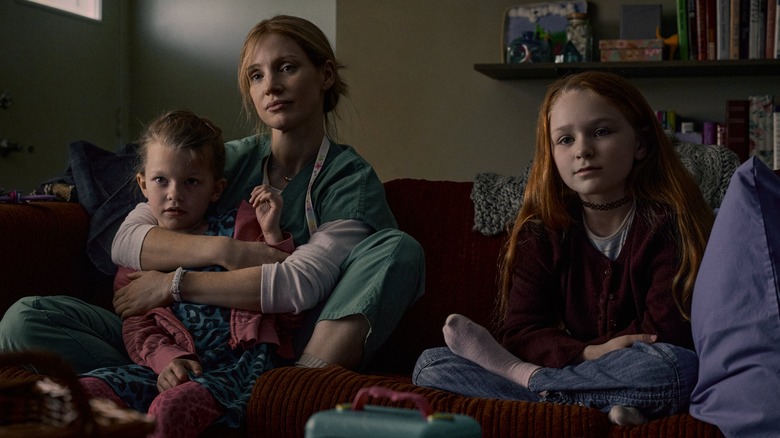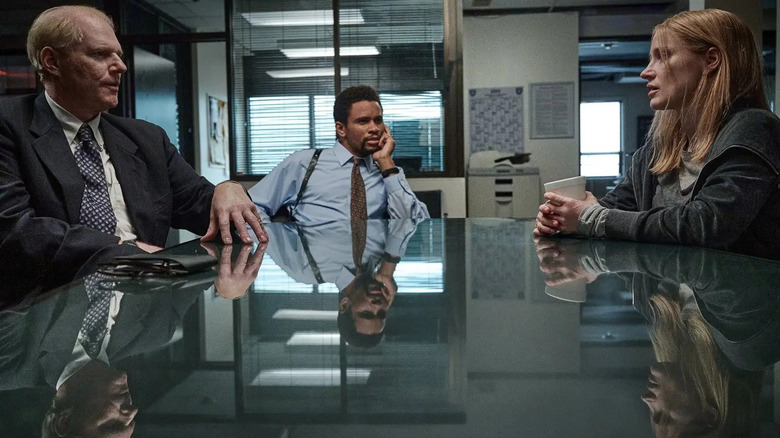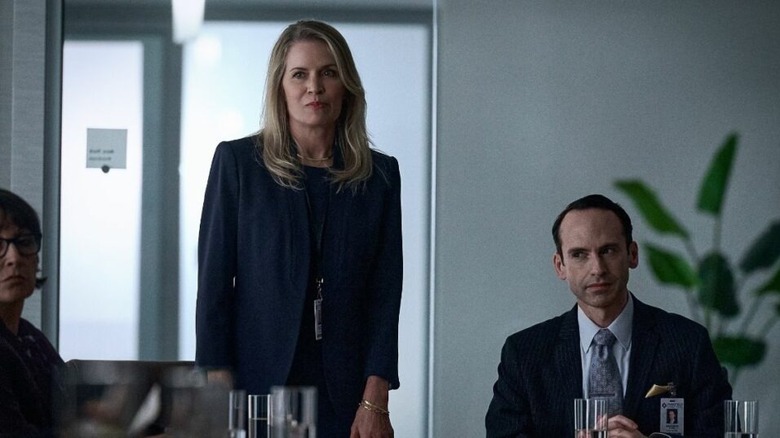The True Story Behind The Good Nurse
"Based on a true story." No five words in cinema have been abused more than those that have opened so many movies. "The Good Nurse" is one of them. Netflix's latest true crime drama is based on the 2013 book by Charles Graeber and documents Charles Cullen, a nurse who murdered patients from 1988 to 2003 by injecting insulin and/or digoxin into IV bags.
Eddie Redmayne plays Cullen in the film, but he's not the lead. That would be his friend and co-worker, Amy Louhgren (Jessica Chastain). She has a good heart, albeit one afflicted with cardiomyopathy, and so comes to rely on "Charlie" during their shared night shifts. After one of their patients dies, though, she slowly discovers his crimes.
So, how true of a story is "The Good Nurse"? While "true story" movies often employ composite characters, Amy Louhgren was the real nurse who helped catch Cullen. The film's personal details of Amy, from her being a single mother to her disease, are accurate as well. The movie isn't free of artistic license though. In centering Amy's story, the movie also doesn't have a chance to touch on all the facts of the case. So, that's what we'll do here.
The story of a killer
As documented by Jennifer Hash of Radford University's Psychology department, Charles Cullen had a troubled personal history. Born in 1960, he was raised with seven siblings by a single mother (his father died when he was seven months old) in New Jersey. At age 17, he became an orphan when his mother was killed in a car accident. Cullen showed homicidal tendencies before he started killing his patients. When he was 18, he poisoned the drinks of his high school bullies, but none of them died.
He served in the Navy from 1978 to 1984, where he was hazed and subjected to disciplinary charges for stealing a hospital gown. After being discharged, he graduated from Mountainside Hospital School of Nursing in 1987. That same year, he married Adrienne Taub and started working at the St. Barnabas Medical Center in Livingston, New Jersey.
1988 was an important year for Cullen. His first daughter was born and he committed his first (known) murder: John Yengo, a 72-year-old Municipal Court judge. Around this time, Cullen began drinking and abusing his family. In 1992, the same year of his second daughter's birth, he was fired from St. Barnabas and moved to Warren Hospital in Phillipsburg, New Jersey. The following year, his wife filed for a restraining order and then divorce. After attempting suicide, Cullen killed the 85-year-old Mary Natoli at Warren.
Cullen cont.
From 1993 to 2003, Cullen worked at seven more hospitals throughout New Jersey and Pennsylvania. Despite suspicion by nurses at St. Luke's hospital in Bethlehem, Pennsylvania, none of the institutions took any action against Cullen beyond dismissal. As The Philadelphia Inquirer reported in 2003, because Cullen was never charged, hospitals he applied to didn't learn of suspicions about him. Thus, he kept finding work — and victims.
As the film shows, Loughren and Cullen befriended each other at Somerset (renamed "Parkfield Memorial Hospital" in the film). After she discovered the truth, Loughren cooperated with Detectives Danny Baldwin (Nnamdi Asomugha) and Tim Braun (Noah Emmerich), even wearing a wire in an unsuccessful attempt to get a confession (According to the real Loughren, the film reduces this conversation from hours to a few minutes).
Charlie was arrested in 2003 and convicted in 2006, sentenced to eleven consecutive life sentences. He is known to have killed 29 people, but the number could be as high as 400. You're probably wondering — why? In a 60 Minutes interview, Cullen claimed he was a mercy killer, but Loughren disputes this:
"There was nothing merciful about what he did... When we sterilize a victim and make it that 'oh, well he just gave them some medicine and then they went to sleep,' that's not what happened. So I do want people to know that those families deserve to have their day, to say they mattered."
Aside from referencing his mother's death, "The Good Nurse" doesn't attempt to explain Cullen either. It alludes to his abusive past and home life but keeps it all offscreen; we never meet his daughters or ex-wife. For one, this allows the audience to see him through Amy's eyes. Second, it's part of the movie's larger goals.
Not centering Cullen
As /Film has written before, it's hard for true crime to avoid exploitation. It's the literal repackaging of real suffering into entertainment. Netflix's "Dahmer" series has ignited a discussion on this. "The Good Nurse" is ultimately akin to "Dahmer" but director Tobias Lindholm at least shows great awareness and sensitivity compared to "Dahmer" creator Ryan Murphy.
While Charles Cullen does drive the story of "The Good Nurse," he isn't the film's POV. The opening is a slow zoom-in on Cullen's face as he watches one of his victims expire. Redmayne's blank expression shows a void, as if spelling out to the audience they can't understand him.
When the film does show empathy for Cullen (such as in his final confession), it's only through Amy's eyes: the two were friends after all. According to Loughren, neither she nor Lindholm felt Cullen should be the film's center.
"Tobias, when I first met him we had a very, very long conversation, we were at dinner and one of the things he kept saying is that this will not be a serial killer movie because I said I want nothing to do with that. I do not want to sensationalize something so despicably dark because I think that's one thing that happens, people are so fascinated with true crime. And he said he wanted to make a movie about hope, and about friendship, and to truly give those ordinary moments a spotlight, to show people that they can be a hero."
Loughren, for her part, felt Graeber's book was more typical true crime fare which spotlight Cullen. She wanted the movie to steer clear of that: "this film is about the absolute heart of how he was caught, and that was through friendship."
Where artistic license is used
Lindholm and Loughren's consideration shows in who "The Good Nurse" does apply the composite character trope to: Cullen's victims. Cullen murders two characters onscreen: Ana Martinez (Judith Delgado) and Kelly Anderson (Anjelica Bosboom), neither of whom were real victims. This isn't a simple name-swap, either; neither's circumstances align perfectly with a real victim.
Lindholm explained this approach to Newsweek:
"I felt that the relatives had been through enough... We wanted to tell their story. We wanted to address the critique of the system for them So, therefore, the only names that we have that are true are Amy and her girls, Charlie, and the police officers. The rest we decided to make anonymous by giving them fictional names. We have also changed the names of the victims. There is nothing in those portrayals [of the deaths] that are 100 percent as it played out, basically to protect relatives now."
Loughren, also speaking to Newsweek, believes that many of the cases are still subject to gag orders, meaning the victims can't even discuss it:
"They can't even talk about it, and I'm happy that now there's going to be a conversation. Now people are going to be asking the right questions and that is who's been held accountable, how many of these hospital bureaucrats are being held accountable? And those are the conversations that I'm looking forward to."
While giving the institutions fictional names does feel exculpatory, "The Good Nurse" isn't shy about condemning the hospitals which allowed Cullen to escape justice.
Cullen's accomplices
Throughout "The Good Nurse," Baldwin and Braun's investigation is stonewalled and outright undermined by the hospital's management, personified by risk manager Linda Garren (Kim Dickens). The hospital only reports Martinez's suspicion death 7 weeks late and mandates Garren be present during questionings to protect the hospital's reputation. This culminates in Garren outright concealing evidence about drug withdrawal records.
If anything, the real Somerset was even worse than the fictional Parkfield. While they were covering for themselves, Cullen killed six more Somerset patients. There's also the detail of why Loughren kept working despite her illness. In irony too cruel to make up, she needed to work at Somerset for a year before getting health insurance. The hospital was meant to provide care, yet didn't even care for their own employee.
The ending text of "The Good Nurse," which details Cullen's fate, notes none of the hospitals have been criminally charged. This paints them as practical accomplices. Beyond that epilogue text, "The Good Nurse" doesn't show Cullen's sentencing, even though there was plenty of dramatic material there. Instead, it ends with Amy in bed with her daughter. A second round of text tells the audience she got her heart transplant and is still living comfortably.
"The Good Nurse" is admirable in its refusal to make a villain like Cullen the centerpiece. Even in a true story, it matters whose story you choose to spotlight.
"The Good Nurse" is streaming on Netflix.
